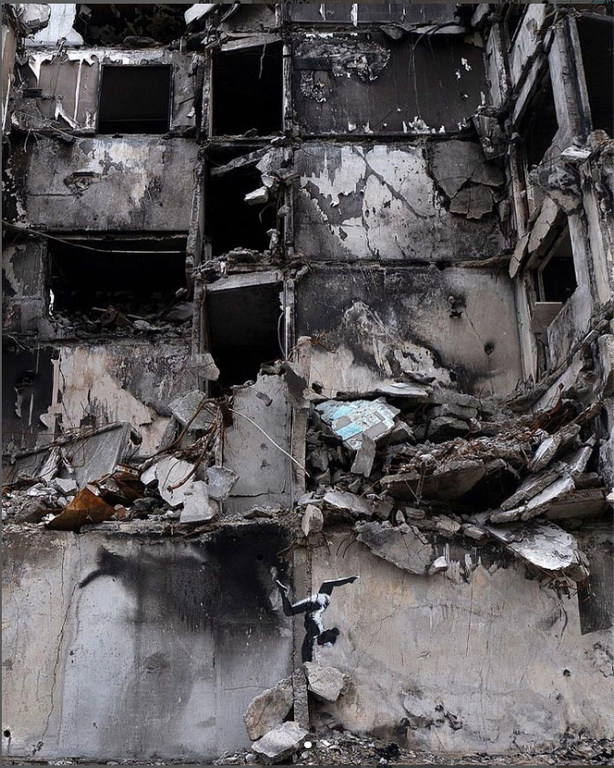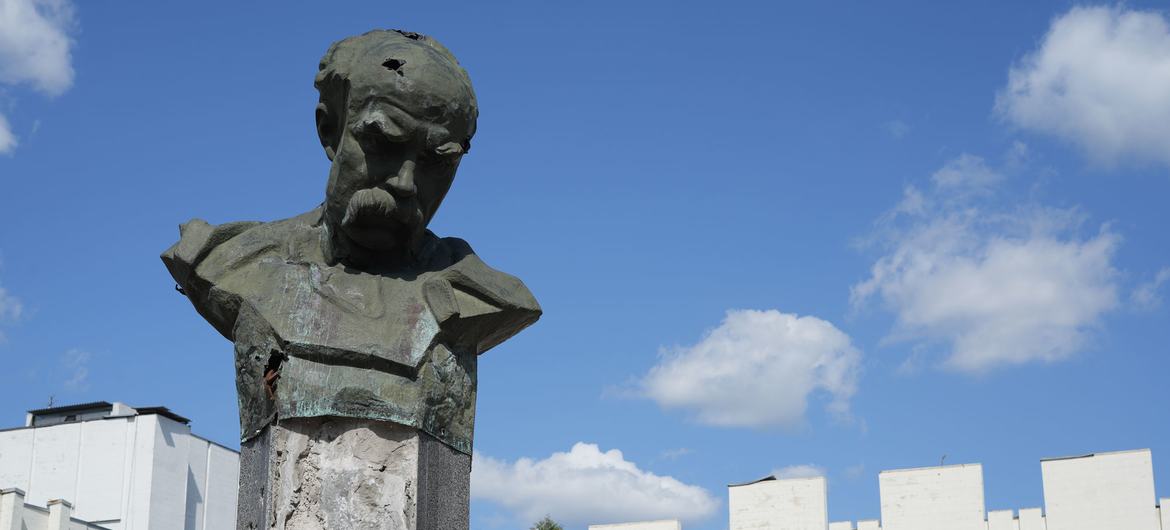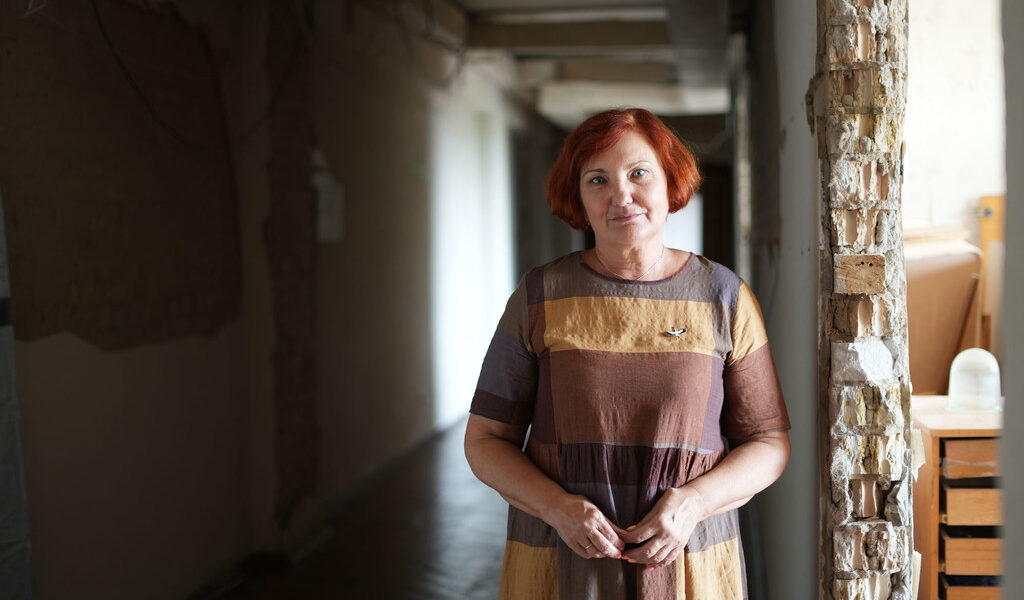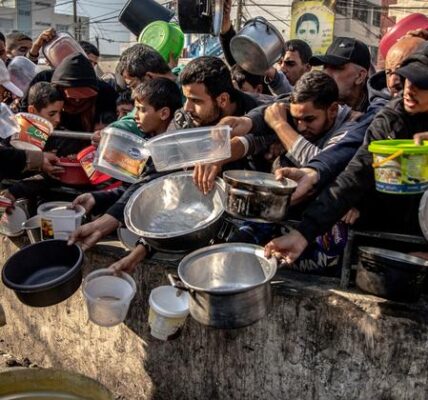The piece of art, depicting a ballerina gracefully standing on rubble, solidified the town’s image as a symbol of strength. Despite gaining attention, the endeavors of local artists, musicians, and librarians to revitalize their cherished hometown are not widely recognized beyond Ukraine.
Currently, there has been a resurgence of cultural events, backed by the International Organization for Migration (IOM) under the United Nations. These events have attracted a large number of attendees, with choirs performing and local artists creating and instructing art in an inspiring manner.

Despite the ongoing conflict, Natalia remains committed to supporting her community in Ukraine in preserving and reviving their cultural heritage.
Revival and resilience
Natalia Vyshynska is committed to reviving cultural life in the town. She and her colleagues have organized several public events since last year.
“We do not refer to it as a ‘concert’,” she clarified. “We use the term ‘a public gathering with musical performances.’ The concerts will take place after we have achieved victory.”
Ms. Vyshynska has been in charge of Borodianka’s culture department for almost 20 years, playing a key role in its recovery and strength. She operates from the cultural center in the town, which bears the marks of war damage and stands near homes that were destroyed in the destructive bombings of March 2022.
Despite the risks associated with warfare, she has continued to show commitment to her coworkers and the significant tasks they undertake. She even went back to the workplace just two days after the invasion to guarantee that employees would receive their salaries.
Starting in April 2022, she and her colleagues spent the next year working in offices with broken windows that were covered in plastic film.
A destroyed city

Banksy, a street artist from Britain, portrayed a dancer maintaining balance amidst the ruins of a home damaged by war in Borodianka, Ukraine.
Ms. Vyshynska, her spouse, daughter-in-law, and two granddaughters sought shelter in a basement during intense combat. After enduring several weeks, they managed to flee and temporarily moved to western Ukraine.
Upon their arrival back home, they discovered that their town had been destroyed. Out of the 26 cultural institutions, 18 had suffered damage or were completely destroyed, resulting in a loss of 95% of their resources and properties. This included a local art school.
“She stated that all of the musical instruments, including a grand piano, were destroyed. Despite storing a 1826 violin in a protective box, it was also destroyed by the fire. The only remaining evidence was a scorched metal violin clef found among the debris.”
Life before war
Before Russia’s attack, Ms. Vyshynska and her colleagues were focused on updating the cultural establishments in Borodianka, a town that had a population of around 13,000 before the war.
Using her knowledge of psychology, she turned a small sewing class into a fashion show, giving students the opportunity to display their designs on stage and build their self-esteem by conquering their fear of presenting their art to a real audience.
Prior to the war, librarians in the town assisted elderly individuals in acquiring digital literacy skills.
Coming home
Although a significant number of youth have departed in search of security and employment in other locations, there has been a consistent influx of individuals returning since the Government of Ukraine regained authority over Borodianka and the northern regions of the nation.
Even as the war persists, numerous individuals who have been displaced choose to go back to their homes. According to Ms. Vyshynska, a majority of those returning are in their 40s and 50s.
Currently, they are engaged in singing.
Recognizing that public events may still be deemed inappropriate by some, she emphasized that these gatherings hold significance for the hundreds of attendees and the organizers involved.
“Some of our vocalists experienced the loss of their family members, and others lost their residences,” she stated. “As a result, they were unable to perform for a period of time. Some required a two-month break, while others needed three months. However, they were able to overcome these challenges and are now back to singing.”
Dealing with death and losses is a common occurrence in the town.
She stated, “We visit the graveyard and reflect on our lost loved ones. I believe they would want life in Borodianka to continue.”

The conflict caused damage to the monument of Taras Shevchenko, a well-known Ukrainian poet.
Healing power of art
Ms. Vyshynska and her team are actively involving psychologists in their work, particularly with regards to children.
“Children are afraid of death, injury, and losing their parents and homes,” she said. “By using drawing, music and games, they can express their fears and traumatizing experiences, and we help them process these difficult emotions and continue with their lives.”
The individuals in her community provide her with resilience and instill a sense of pride within her. She can easily identify numerous instances as evidence.
Valentyn Moiseenko, a knowledgeable historian of the local area, miraculously survived the bombing of Borodianka alongside his wife, who has a mobility limitation. They sought refuge in a basement for several weeks. Drawing from his experiences, Moiseenko authored a book detailing the town’s struggles while under Russian military control and amidst intense combat.
Svitlana Vyskochy is a talented artist and resident of the town who specializes in making beautifully decorated Easter eggs known as pysankas. She generously offers her skills by teaching master classes to hospital patients on a weekly basis, including those who have experienced amputations.

Natalia’s team designed pins featuring the phrase “Borodianka’s culture is alive” and the iconic maiolica rooster.
The culture of Borodianka is thriving.
The team led by Ms. Vyshynska has created pins featuring the iconic maiolica rooster and the phrase “Borodianka’s culture is thriving”.
The cultural center of the town depends on funding from corporations and global institutions.
A project, funded by the Republic of Korea and Canada through the UN International Organization for Migration (IOM), is supporting the renovation of a local museum. Additionally, it aims to establish a family-friendly area, supply equipment for a nearby library, and provide a large tent for Ms. Vyshynska’s team to deliver services to those affected by war in Borodianka.
With assistance from IOM, she and fellow community members participated in open discussions, where they had the opportunity to collaboratively influence the direction of their community by implementing projects promoting societal transformation.
With the help of volunteers from all over Ukraine, they utilized these abilities to revamp their cultural hub in order for Borodianka to preserve its distinct culture for future generations to enjoy.

The sculpture “Girl under the Sun” symbolizes triumph of existence over devastation.
Source: news.un.org




